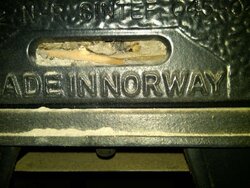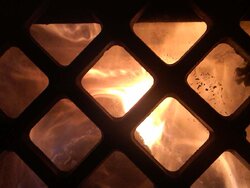Alright then, here's the update...
1. I was getting secondary burn, but not enthusiastic. I have the wrong gasket on the glass, letting in too much air (I STILL can't find the correct one locally). So I mostly sealed the top airwash inlet with more gasket, which made the burns more manageable and a much better secondary burn. Seems that the turbulence of all that air entering does in fact kill the secondaries. Either that or air was being preferentially drawn in the front.
2. Fires are easier to start/catch faster on the new stove.
3. Precaud is right, in that this may not get as hot as quickly as the old stove. I noticed that I was getting poor heat output despite 600+' stove top temps. So I measured elsewhere. The ONLY part of the stove that was 600' was the cook plate before I reduced the air. If I measured 1" off of it, the temps are 200' less. The sides and back are much lower still, and until everything REALLY gets cranking, they're in the 2-300' range. So what it takes is to get the cook plate to 800+' during the hot part of the burn. I know this is high, but again, at this point the rest of the stove is in the 600' range, and the flue exit temps are in the 500's. If I run it this way, then my sides end up in the 500's, and top (aside from the plate) is in the 600's, and I get good heat output.
4. I think that I get a longer period of hot temps (see above) with this stove. It does coal up, but the coals are HOT. I can easily maintain my temps in the high 400's-500's until the coals burn down. I can burn them down quick if I open the air.
5. Have more coals in the rear of the stove, but everything still burns down fine. Still toying with adding more 2' air inlets back there, but I'll wait a bit on that.
6. It burns MUCH cleaner. No smoke from the chimney. Old stove I always had smoke, no matter how hot I was burning.
I think this is trickier to burn than the old one. If I leave the air open, the cook plate gets hot but nothing else does. If I close it too early, everything heats evenly but slowly, and nothing gets as hot. Closing in stages seems to work best (not necessary on the old stove); get it caught, then reduce the air until the flames get just a bit lazy (not violently whipping). At this point the secondaries kick in more, and everything heats up nice. Once my cook plate reaches 700-750', I close down all the way or nearly so, it heats up a bit more, and go from there. Seems like I mess with the air on this one more, but at least part of that is that I can now see the flames I think.
EDIT: Forgot to mention that the old stove heated more uniformly--sides heated quickly, which I think accounts for the difference in heat output. Again, I think the outputs are close once I get the sides radiating on the new stove. The insulation on the new stove I assume is the culprit. It allows the firebox to heat quicker at the expense of radiating heat initially.




